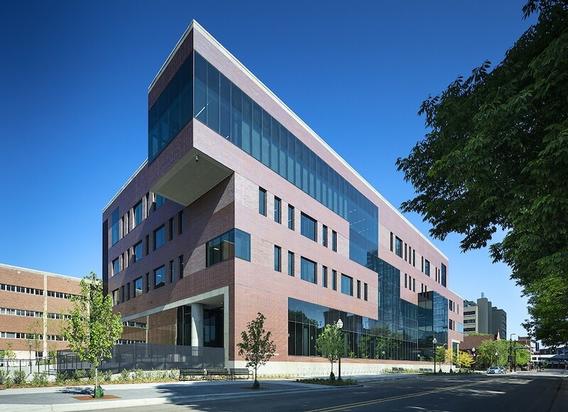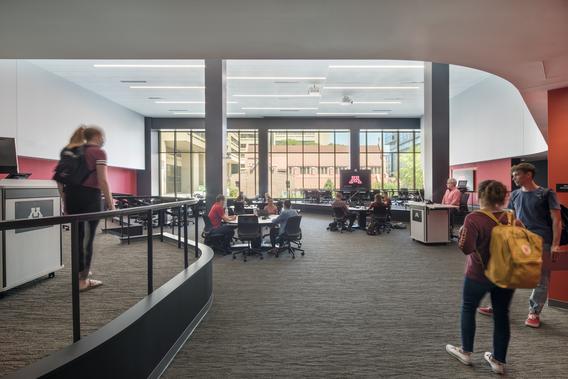
Today’s new models of health care require different professions to work together in close collaboration, using new strategies and new technologies. Preparing for that world requires new ways of teaching and learning for our students.
The Health Sciences Education Center is designed to transform health education in Minnesota by moving from the lecture hall to active, team-based learning in the same type of small-group environments that students will encounter as practicing healthcare professionals.
HSEC is open to all University of Minnesota students and serves as the hub for all health professional schools. HSEC’s spaces promote interprofessional education and interaction as well as foster a culture that values student and faculty well-being.
HSEC is home to:
Facility Details

At 202,000 gross square feet, the Health Sciences Education Center is one of the most comprehensive interprofessional education facilities in the country.
HSEC's focus is on active, team-based learning in small-group environments, and has been designed to transform health education in Minnesota. HSEC offers places to connect, collaborate and communicate across the health sciences.
Located on the University of Minnesota Twin Cities campus at the intersection of Harvard and Delaware streets, HSEC connects and extends into the Phillips-Wangensteen Building (PWB).
7TH FLOOR HSEC - IP LOUNGE, CLASSROOMS, EVENT SPACE
- Interprofessional student lounge
- Flexible space that can be used for classes, computerized testing, events, two rooms can be combined for 400+ seats, small catering support space
- 60 seats of open study space in a variety of configurations
- Center for Health Interprofessional Program (CHIP) staff office and meeting space for student groups
- Wellness studio for yoga, etc.
- 1 Wellness/Lactation room, 1 Gender Neutral restroom
6TH FLOOR HSEC - INPATIENT SIMULATION
- 7 flexible fully immersive inpatient simulation rooms, varying sizes
- Acute care suite
- 2 Operating rooms
- Trauma simulation suite
- Nurse station, med prep room, anteroom for infection control scenarios, patient bathroom.
- Air and vacuum ports on the Sim Hospital headwalls are fully functional; the oxygen port will have regular air. Any equipment requiring true oxygen will use a portable oxygen tank.
- Control rooms for recording
- 4 Brief and de‐brief rooms with 16 seats, flexible furniture
- Technology trainer room for simulation training
- Wet/dry trainer station room with adjacent lab support room
- Innovation Partner Discovery Room – for presentations by outside groups
- Simulation workshop
- Storage (simulation storage needs are very high, manikins, wheelchairs, hospital beds, gurneys require a lot of space)
- Faculty and staff office space
- 40 seats of open study space in a variety of configurations
5TH FLOOR PWB - HEALTH SCIENCE LIBRARY
- Circulation/help desk
- Faculty Commons – where faculty can explore new teaching methods and experiment with the same technology that is in the classrooms
- Computer Visualization Lab‐ seats 30, with technology rich infrastructure for manipulating large data, i.e. study world epidemics
- Six (6) One‐button studios, where students and faculty can record their own presentations, very user friendly
- 28 computer workstations ‐ for general use
- Three (3) consult rooms where library staff can meet with faculty, staff and students on special projects and two (2) small group study rooms
- Office space for library staff
- Small percentage of book and materials stacks will be housed in lower level of PWB, majority of materials will be stored off‐campus but available on short notice.
5TH FLOOR HSEC - SIMULATION AND HEALTH SCIENCES LIBRARY
- 18 outpatient exam rooms
- Standardized patient orientation/breakroom for 24 participants
- Monitoring/control A/V rooms
- Two (2) 24 seat Brief/Debrief multi‐use rooms where students can review their performance and receive feedback from faculty and peers
- Virtual Reality studio
- Maker Space with 3D printers
- Quiet study room with 155 seats
- Open study space with 60 seats
4TH FLOOR PWB AND HSEC - SMALL GROUP ROOMS, STUDY
- Vertical connection between floors 2, 3, 4 and 5 on south side of PWB plus horizontal connection to HSEC.
- Six (6) small group teaching/study rooms, 16 seats per room
- Open study spaces with 48 seats
3RD FLOOR PWB - CLASSROOMS, STUDENT SERVICES
- 4 classrooms with movable tables and chairs, accommodates 32‐50 seats per room, ability to combine two rooms
- Health Sciences “Front Door” office space for Student Services, Financial Aid, Recruitment, Visitors
- Renovated main lobby to accommodate patient waiting from clinics and 10 person conference room
3RD FLOOR HSEC - MAIN LOBBY, CLASSROOMS, FOOD SERVICE
- Street level entrance into 2‐story lobby space
- 144 seat collaborative bi‐level active learning classroom to support group collaboration, 18 fixed tables of 8 students per table, movable chairs, 8 flat panel displays where students can share their work.
- 206 seat shallow tired active learning auditorium to supports group collaboration as well as lecture style instruction or presentations.
- 170 seats of open study space in a variety of configurations
- Food service area (Minnesota Mug) on south end, with exterior seating on plaza for warmer months
2ND FLOOR PWB - SEMINAR ROOMS, WANGENSTEEN HISTORICAL COLLECTION, INTERPROFESSIONAL STUDENT LOCKERS
- 5 Seminar/large group study rooms, 16 seats per room, with video conferencing to enable distance learning with other campuses
- 5 small group study rooms, 4 seats per room
- 85 seats of open study space in various configurations
- New interprofessional student locker space
- Wangensteen Historical Collection – offices, preservation area, reading room and conference room with 64 – 100 seats (The actual collection will be stored on the basement level of PWB)
2ND FLOOR HSEC - ACTIVE LEARNING CLASSROOMS
- 135 seat active learning distance classroom, 9 students per table, supports programs that have a presence in Duluth and Rochester
- 144 seat active learning divisible distance classroom, 9 students per table, supports programs that have a presence in Duluth and Rochester
- 4 Seminar/large group study rooms with 14 – 16 seats
- 2 Small group study rooms with 8 seats/room
- 2 Wellness/lactation rooms
- Provides connection to tunnel that connects the parking ramp with the hospital